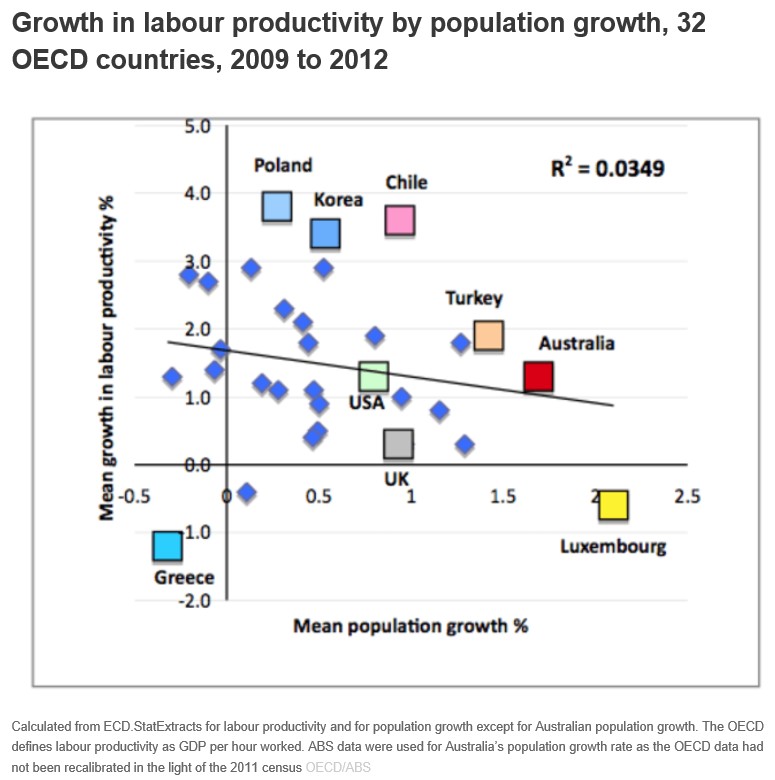Fairfax’s Harold Mitchell posted an article over the weekend warning that the Australian economy will struggle unless it can fire-up the “three Ps”:
…we are in trouble unless we change. Our population growth is slowing and its growth rate is at its lowest level in a decade and is forecast to slow further. That’s bad news.
Net migration is the major cause, because although births peaked in 2013, we will have fewer people than a vibrant economy needs.
Workforce participation has been at a standstill since 2008 and is forecast to decline over the next 15 years as the proportion of the population aged 15-64, our workforce, has peaked.
Productivity has also been at a standstill since 2004 and personal expenditure, which keeps the economy ticking over, is sluggish and may fall further. Only government consumption kept GDP from declining in the last quarter…
The “three P’s” is, of course, the framework used by the Australian Treasury to boost Australia’s living standards.
According to this framework, Australia must: 1) boost productivity; 2) raise workforce participation; and 3) increase the population via skilled migration, if the nation is to continue to enjoy rising living standards.
Personally, I do not subscribe to the three P’s framework, and would prefer that it was pared back to the “Two Ps” of productivity and participation.
Of the three P’s, boosting productivity is by far the most important driver of rising living standards over the long-term, since it allows more goods/services to be produced (consumed) from less effort.
Raising labour force participation can also raise living standards. However, working more hours (increasing participation) can mean that less time is available for other pursuits, such as relaxing or meeting-up with friends. So while working more will, other things equal, raise incomes and GDP, it can also take away from the other pleasures in life, reducing its benefit.
By contrast, population growth’s impact on living standards is highly questionable. While it certainly does raise headline GDP (more inputs equals more outputs), there are significant doubts over whether it raises per capita GDP, while also placing greater pressure on the environment, pre-existing infrastructure and housing, and Australia’s fixed endowment of mineral resources (see here for a detailed run-down of the issues).
Indeed, Katharine Betts, an Adjunct Associate Professor of Sociology at Swinburne University of Technology, has found that that data from 32 OECD countries show no statistically significant association between productivity and population growth:

Dr Betts has also called on Treasury to reduce the trifecta of the three Ps to a duo of productivity and participation:
…the deep shortcomings of GDP as a measure of well-being are now all too well known; for example the misery that commuters experience stuck in traffic shows up as a positive for GDP (more petrol consumed, more costly wear and tear on vehicles), and the GDP takes no count at all of the drag that the congestion imposes on productivity. In contrast the State of Australian Cities report predicts traffic congestion in the major cities will cost Australians A$20.4 billion a year by 2020 and stories of its ill effects on productivity are commonplace…
High immigration may have no effect on productivity, as the figure above shows, or as the Australian experience suggests, may reduce it. And it can be irrelevant to participation.
Thankfully, it appears that Australia’s policy makers are starting to see the light.
Back in March, current Treasury secretary, John Fraser, provided a lukewarm assessment of population growth via immigration [my emphasis]:
In recent years, Australia’s population growth has been amongst the fastest in the developed world, driven by migration.
A growing population can be a source of dynamism for the economy.
It provides a larger domestic market for business, increases the size of the labour force and facilitates the injection of new ideas.
But it also places additional demands on government budgets in areas such as infrastructure, health and education.
I have seen this firsthand in the United Kingdom where the results are very sobering.
In July, RBA Governor Glenn Stevens took a veiled swipe at Australia’s high immigration program, endorsing a shift away from quantitative measures to boost growth, such as high immigration, to qualitative measures that improve productivity and living standards on a per capita basis.
Then in August, the National Reform Summit released its final statement, which included an entire section on the need to boost productivity and participation, but excluded any mention of the need for population growth (immigration) in order to improving living standards.
Hopefully, this omission represents a belated acknowledgement from Australia’s leaders and policy makers that high immigration is not an economic bonanza, and is in fact just as likely to damage the nation’s productivity and living standards.
The next step is for the Australian Treasury to dump the Three P’s framework in favour of the Two Ps.

